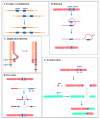Chromosome Evolution in Connection with Repetitive Sequences and Epigenetics in Plants
- PMID: 29064432
- PMCID: PMC5664140
- DOI: 10.3390/genes8100290
Chromosome Evolution in Connection with Repetitive Sequences and Epigenetics in Plants
Abstract
Chromosome evolution is a fundamental aspect of evolutionary biology. The evolution of chromosome size, structure and shape, number, and the change in DNA composition suggest the high plasticity of nuclear genomes at the chromosomal level. Repetitive DNA sequences, which represent a conspicuous fraction of every eukaryotic genome, particularly in plants, are found to be tightly linked with plant chromosome evolution. Different classes of repetitive sequences have distinct distribution patterns on the chromosomes. Mounting evidence shows that repetitive sequences may play multiple generative roles in shaping the chromosome karyotypes in plants. Furthermore, recent development in our understanding of the repetitive sequences and plant chromosome evolution has elucidated the involvement of a spectrum of epigenetic modification. In this review, we focused on the recent evidence relating to the distribution pattern of repetitive sequences in plant chromosomes and highlighted their potential relevance to chromosome evolution in plants. We also discussed the possible connections between evolution and epigenetic alterations in chromosome structure and repatterning, such as heterochromatin formation, centromere function, and epigenetic-associated transposable element inactivation.
Keywords: epigenetic modification; plant chromosome evolution; repetitive sequences; transposable elements.
Conflict of interest statement
The authors declare no conflict of interest.
Figures



References
-
- Weiss-Schneeweiss H., Schneeweiss G. Karyotype diversity and evolutionary trends in Angiosperms. In: Greilhuber J., Dolezel J., Wendel J.F., editors. Plant Genome Diversity. Volume 2. Springer; Vienna, Austria: 2013. pp. 209–230.
Publication types
LinkOut - more resources
Full Text Sources
Other Literature Sources

